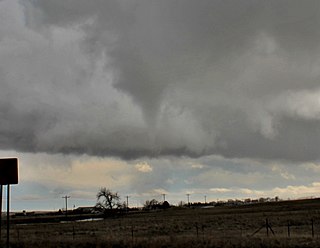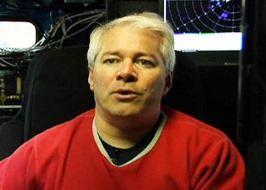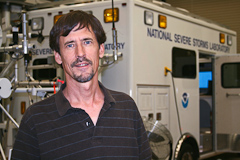
A thunderstorm, also known as an electrical storm or a lightning storm, is a storm characterized by the presence of lightning and its acoustic effect on the Earth's atmosphere, known as thunder. Relatively weak thunderstorms are sometimes called thundershowers. Thunderstorms occur in a type of cloud known as a cumulonimbus. They are usually accompanied by strong winds and often produce heavy rain and sometimes snow, sleet, or hail, but some thunderstorms produce little precipitation or no precipitation at all. Thunderstorms may line up in a series or become a rainband, known as a squall line. Strong or severe thunderstorms include some of the most dangerous weather phenomena, including large hail, strong winds, and tornadoes. Some of the most persistent severe thunderstorms, known as supercells, rotate as do cyclones. While most thunderstorms move with the mean wind flow through the layer of the troposphere that they occupy, vertical wind shear sometimes causes a deviation in their course at a right angle to the wind shear direction.

A mesoscale convective system (MCS) is a complex of thunderstorms that becomes organized on a scale larger than the individual thunderstorms but smaller than extratropical cyclones, and normally persists for several hours or more. A mesoscale convective system's overall cloud and precipitation pattern may be round or linear in shape, and include weather systems such as tropical cyclones, squall lines, lake-effect snow events, polar lows, and mesoscale convective complexes (MCCs), and generally forms near weather fronts. The type that forms during the warm season over land has been noted across North and South America, Europe, and Asia, with a maximum in activity noted during the late afternoon and evening hours.

The US National Center for Atmospheric Research is a US federally funded research and development center (FFRDC) managed by the nonprofit University Corporation for Atmospheric Research (UCAR) and funded by the National Science Foundation (NSF). NCAR has multiple facilities, including the I. M. Pei-designed Mesa Laboratory headquarters in Boulder, Colorado. Studies include meteorology, climate science, atmospheric chemistry, solar-terrestrial interactions, environmental and societal impacts.

Tornadogenesis is the process by which a tornado forms. There are many types of tornadoes and these vary in methods of formation. Despite ongoing scientific study and high-profile research projects such as VORTEX, tornadogenesis is a volatile process and the intricacies of many of the mechanisms of tornado formation are still poorly understood.

In meteorology and climatology, a mesonet, portmanteau of mesoscale network, is a network of automated weather and, often also including environmental monitoring stations, designed to observe mesoscale meteorological phenomena and/or microclimates.

Joshua Michael Aaron Ryder Wurman is an American atmospheric scientist and inventor noted for tornado, tropical cyclone, and weather radar research.

The Verification of the Origins of Rotation in Tornadoes Experiment are field experiments that study tornadoes. VORTEX1 was the first time scientists completely researched the entire evolution of a tornado with an array of instrumentation, enabling a greater understanding of the processes involved with tornadogenesis. A violent tornado near Union City, Oklahoma was documented in its entirety by chasers of the Tornado Intercept Project (TIP) in 1973. Their visual observations led to advancement in understanding of tornado structure and life cycles.
Howard Bruce Bluestein is a research meteorologist known for his mesoscale meteorology, severe weather, and radar research. He is a major participant in the VORTEX projects. A native of the Boston area, Dr. Bluestein received his Ph.D. in 1976 from MIT. He has been a professor of meteorology at the University of Oklahoma (OU) since 1976.
A mesohigh is a mesoscale high-pressure area that forms beneath thunderstorms. While not always the case, it is usually associated with a mesoscale convective system. In the early stages of research on the subject, the mesohigh was often referred to as a "thunderstorm high".
Hydrometeor loading is the induced drag effects on the atmosphere from a falling hydrometeor. When falling at terminal velocity, the value of this drag is equal to grh, where g is the acceleration due to gravity and rh is the mixing ratio of the hydrometeors. Hydrometeor loading has a net-negative effect on the atmospheric buoyancy equations. As the hydrometeor falls toward the surface, the surrounding air provides resistance against the acceleration due to gravity, and the air in the vicinity of the hydrometeor becomes denser. The increased weight of the atmosphere can support a present downdraft or even cause a downdraft to occur. Hydrometeor loading can also lead to increased high pressure inside of a mesohigh in a thunderstorm.

Roger M. Wakimoto is an atmospheric scientist specializing in research on mesoscale meteorology, particularly severe convective storms and radar meteorology. A former director of the National Center for Atmospheric Research (NCAR), Wakimoto in November 2012 was appointed as assistant director of the Directorate for Geosciences (GEO) of the National Science Foundation (NSF).

Erik Nels Rasmussen is an American meteorologist and leading expert on mesoscale meteorology, severe convective storms, forecasting of storms, and tornadogenesis. He was the field coordinator of the first of the VORTEX projects in 1994-1995 and a lead principal investigator for VORTEX2 from 2009-2010 and VORTEX-SE from 2016-2017, as well as involved in other smaller VORTEX offshoots and many field projects.
David Owen Blanchard is an American meteorologist, photographer, and storm chaser. He was a significant collaborator in seminal research on tornadogenesis, specifically the importance of baroclinic boundaries, the rear-flank downdraft (RFD) and its thermodynamic characteristics.
Jeffrey W. Frame is an American atmospheric scientist known for observational and modeling studies of severe convective storms and for teaching meteorology. He was a scientist for VORTEX2 and other field research programs.

Donald W. Burgess is an American meteorologist who has made important contributions to understanding of severe convective storms, particularly tornadoes, radar observations and techniques, as well as to training other meteorologists. He was a radar operator during the first organized storm chasing expeditions by the University of Oklahoma (OU) in the early 1970s and participated in both the VORTEX projects.
Yvette Richardson is an American meteorologist with substantial contributions on tornado dynamics, tornadogenesis, the environments of tornadoes, supercells, and severe convection, and radar observations of these. She was a principal investigator (PI) of VORTEX2.
David C. Dowell is American atmospheric scientist recognized for research on tornado structure and dynamics and on tornadogenesis. He participated in both of the VORTEX projects.

Robert A. Houze, Jr., is an American atmospheric scientist, researcher, author, and Professor Emeritus of Atmospheric Sciences at the University of Washington where he led a research team known as the Mesoscale Group for 46 years. He and his group participated in international field projects around the world and global satellite programs employing weather radar and aircraft in the tropics and midlatitudes, in projects sponsored by NSF, NASA, DOE, and NOAA. Houze has been on the science teams for three NASA satellites for the global study of clouds and precipitation. The predominant areas of his research are tropical convective clouds, extreme storms, flooding in the Asian Monsoon, tropical cyclones, and midlatitude frontal systems in mountainous regions.
Rebecca Suzanne Hornbrook is an atmospheric chemist at the National Center for Atmospheric Research (NCAR). She currently holds the position of Project Scientist II while also belonging to a variety of groups based out of NCAR, UCAR, and NASA. She is notable for her work as one of the leading experts in Volatile organic compounds (VOCs) while possessing an interest in air quality, biosphere-atmosphere interactions, chemical kinetics, and photochemistry.

The Rapid X-band Polarimetric Radar, commonly abbreviated as RaXPol, is a mobile research radar designed and operated by the University of Oklahoma, led by Howard Bluestein. RaXPol often collaborates with adjacent mobile radar projects, such as Doppler on Wheels and SMART-R. Unlike its counterparts, RaXPol typically places emphasis on temporal resolution, and as such is capable of surveilling the entire local atmosphere in three dimensions in as little as 20 seconds, or a single level in less than 3 seconds.












